Reflective Paper: Immunization Promotion Using Rolfe's Model
VerifiedAdded on 2022/11/25
|6
|1508
|416
Report
AI Summary
This reflective paper, utilizing Rolfe's reflective model (What? So what? Now what?), examines strategies to promote immunization coverage among infants and young children. The paper begins by highlighting the importance of vaccination against vaccine-preventable diseases (VPDs) and the need to increase immunization rates, referencing research and healthcare statistics. It then details interventions such as home visits, reduced costs, and community-based programs, and discusses the positive outcomes of increased vaccination, including reduced deaths, disability, and improved health. The paper concludes by emphasizing the long-term benefits of disease prevention, including economic savings and a more productive population, and the need for continued governmental and healthcare taskforce support for immunization programs. The author reflects on their experience creating a poster to increase awareness and understanding the importance of vaccination.
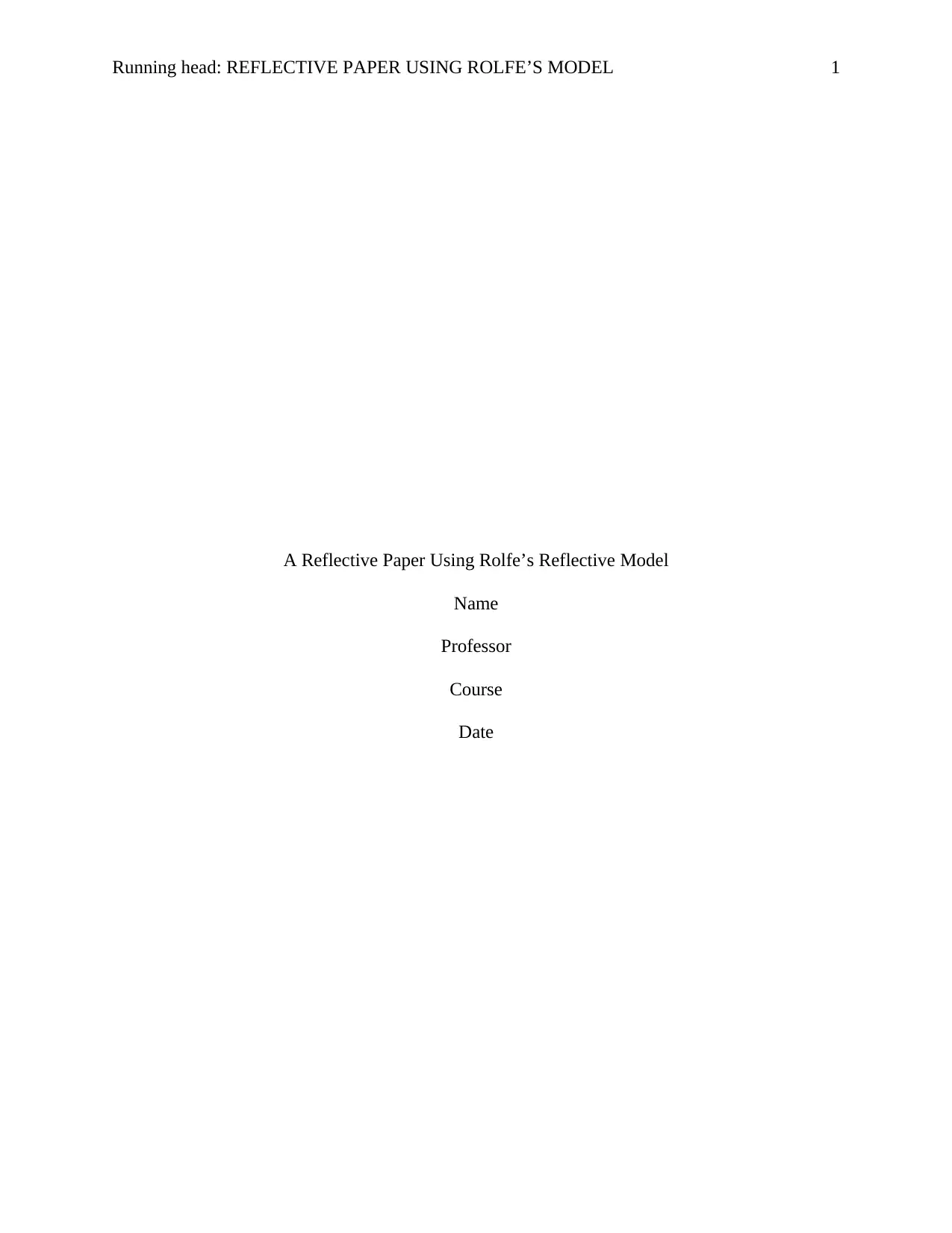
Running head: REFLECTIVE PAPER USING ROLFE’S MODEL 1
A Reflective Paper Using Rolfe’s Reflective Model
Name
Professor
Course
Date
A Reflective Paper Using Rolfe’s Reflective Model
Name
Professor
Course
Date
Paraphrase This Document
Need a fresh take? Get an instant paraphrase of this document with our AI Paraphraser
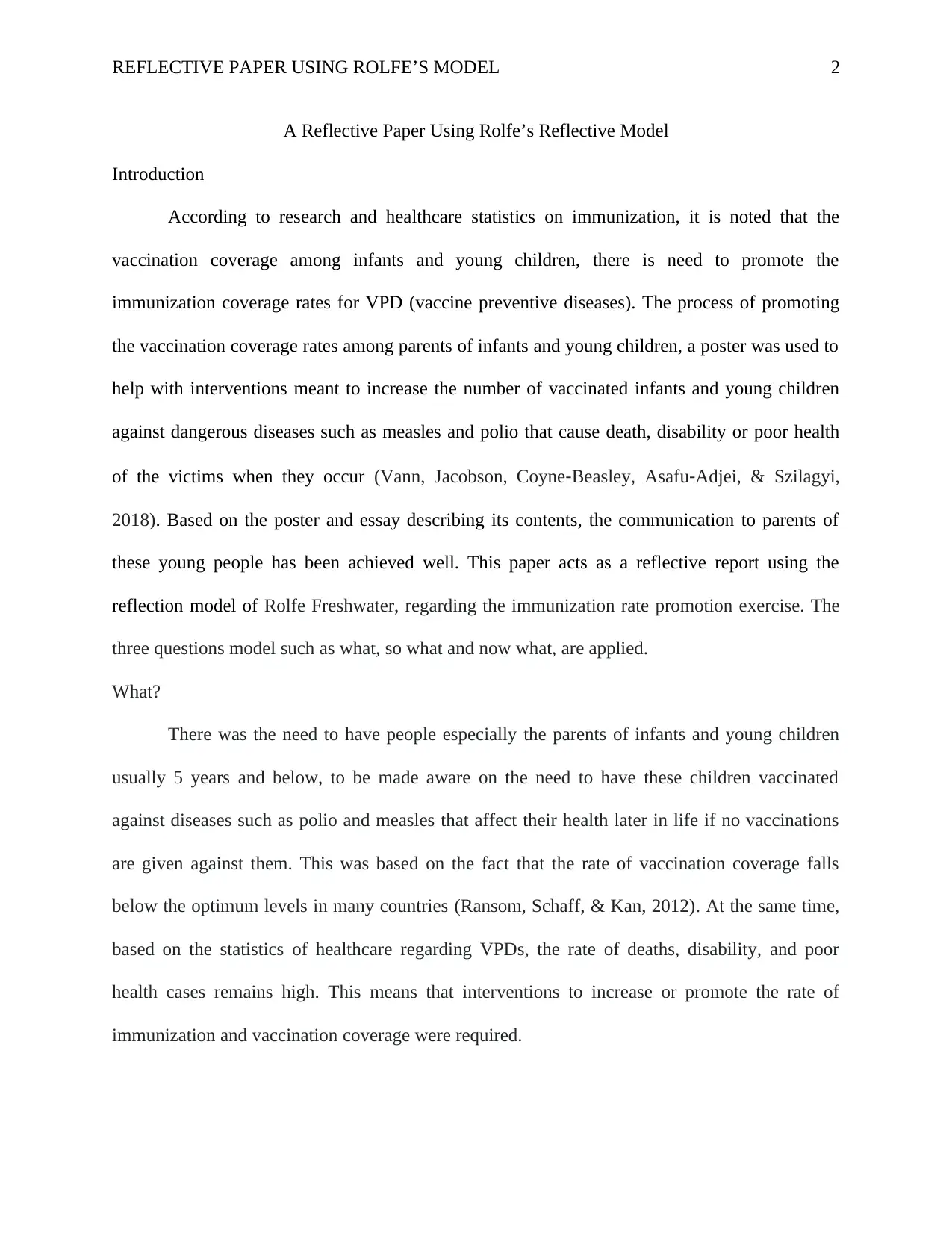
REFLECTIVE PAPER USING ROLFE’S MODEL 2
A Reflective Paper Using Rolfe’s Reflective Model
Introduction
According to research and healthcare statistics on immunization, it is noted that the
vaccination coverage among infants and young children, there is need to promote the
immunization coverage rates for VPD (vaccine preventive diseases). The process of promoting
the vaccination coverage rates among parents of infants and young children, a poster was used to
help with interventions meant to increase the number of vaccinated infants and young children
against dangerous diseases such as measles and polio that cause death, disability or poor health
of the victims when they occur (Vann, Jacobson, Coyne‐Beasley, Asafu‐Adjei, & Szilagyi,
2018). Based on the poster and essay describing its contents, the communication to parents of
these young people has been achieved well. This paper acts as a reflective report using the
reflection model of Rolfe Freshwater, regarding the immunization rate promotion exercise. The
three questions model such as what, so what and now what, are applied.
What?
There was the need to have people especially the parents of infants and young children
usually 5 years and below, to be made aware on the need to have these children vaccinated
against diseases such as polio and measles that affect their health later in life if no vaccinations
are given against them. This was based on the fact that the rate of vaccination coverage falls
below the optimum levels in many countries (Ransom, Schaff, & Kan, 2012). At the same time,
based on the statistics of healthcare regarding VPDs, the rate of deaths, disability, and poor
health cases remains high. This means that interventions to increase or promote the rate of
immunization and vaccination coverage were required.
A Reflective Paper Using Rolfe’s Reflective Model
Introduction
According to research and healthcare statistics on immunization, it is noted that the
vaccination coverage among infants and young children, there is need to promote the
immunization coverage rates for VPD (vaccine preventive diseases). The process of promoting
the vaccination coverage rates among parents of infants and young children, a poster was used to
help with interventions meant to increase the number of vaccinated infants and young children
against dangerous diseases such as measles and polio that cause death, disability or poor health
of the victims when they occur (Vann, Jacobson, Coyne‐Beasley, Asafu‐Adjei, & Szilagyi,
2018). Based on the poster and essay describing its contents, the communication to parents of
these young people has been achieved well. This paper acts as a reflective report using the
reflection model of Rolfe Freshwater, regarding the immunization rate promotion exercise. The
three questions model such as what, so what and now what, are applied.
What?
There was the need to have people especially the parents of infants and young children
usually 5 years and below, to be made aware on the need to have these children vaccinated
against diseases such as polio and measles that affect their health later in life if no vaccinations
are given against them. This was based on the fact that the rate of vaccination coverage falls
below the optimum levels in many countries (Ransom, Schaff, & Kan, 2012). At the same time,
based on the statistics of healthcare regarding VPDs, the rate of deaths, disability, and poor
health cases remains high. This means that interventions to increase or promote the rate of
immunization and vaccination coverage were required.
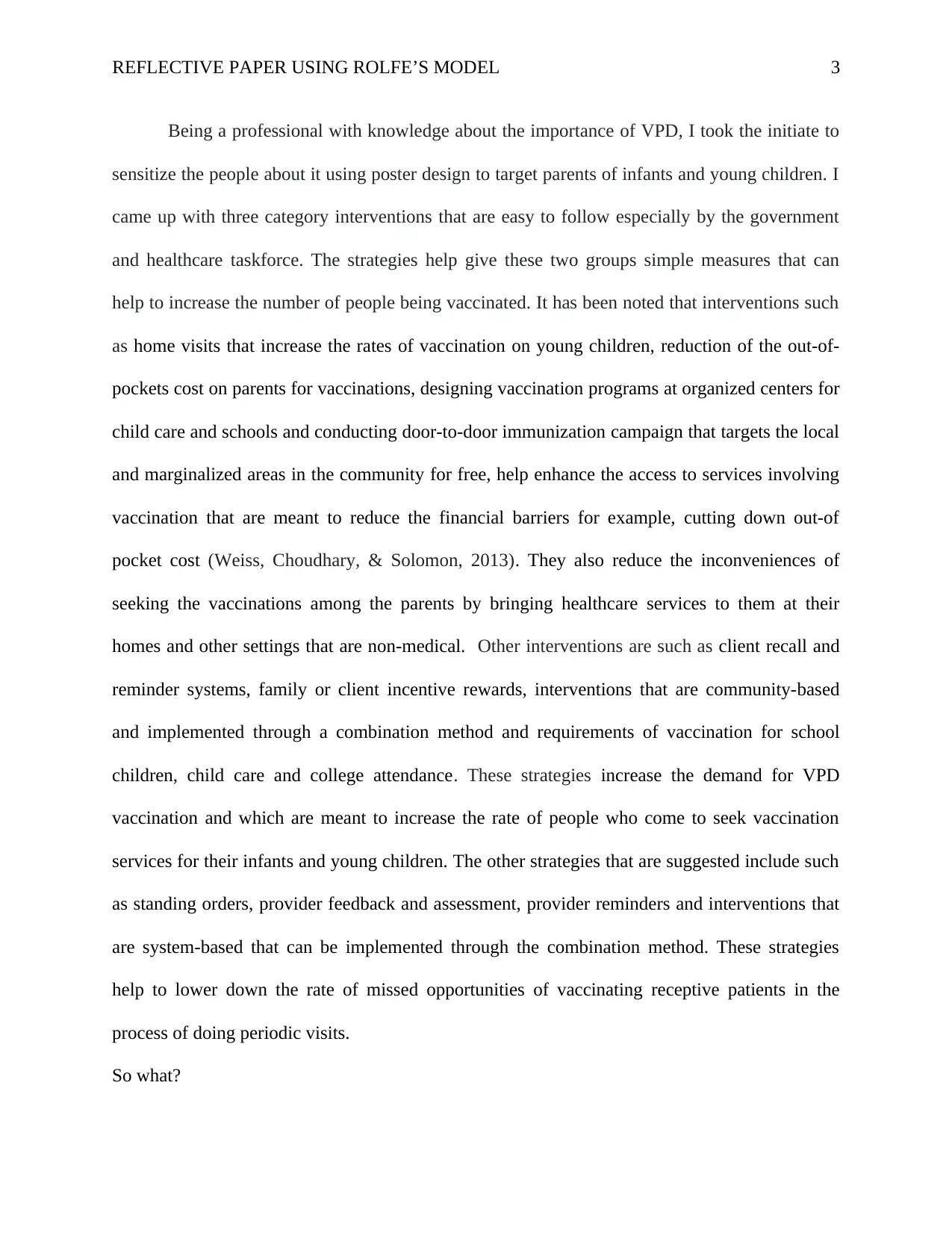
REFLECTIVE PAPER USING ROLFE’S MODEL 3
Being a professional with knowledge about the importance of VPD, I took the initiate to
sensitize the people about it using poster design to target parents of infants and young children. I
came up with three category interventions that are easy to follow especially by the government
and healthcare taskforce. The strategies help give these two groups simple measures that can
help to increase the number of people being vaccinated. It has been noted that interventions such
as home visits that increase the rates of vaccination on young children, reduction of the out-of-
pockets cost on parents for vaccinations, designing vaccination programs at organized centers for
child care and schools and conducting door-to-door immunization campaign that targets the local
and marginalized areas in the community for free, help enhance the access to services involving
vaccination that are meant to reduce the financial barriers for example, cutting down out-of
pocket cost (Weiss, Choudhary, & Solomon, 2013). They also reduce the inconveniences of
seeking the vaccinations among the parents by bringing healthcare services to them at their
homes and other settings that are non-medical. Other interventions are such as client recall and
reminder systems, family or client incentive rewards, interventions that are community-based
and implemented through a combination method and requirements of vaccination for school
children, child care and college attendance. These strategies increase the demand for VPD
vaccination and which are meant to increase the rate of people who come to seek vaccination
services for their infants and young children. The other strategies that are suggested include such
as standing orders, provider feedback and assessment, provider reminders and interventions that
are system-based that can be implemented through the combination method. These strategies
help to lower down the rate of missed opportunities of vaccinating receptive patients in the
process of doing periodic visits.
So what?
Being a professional with knowledge about the importance of VPD, I took the initiate to
sensitize the people about it using poster design to target parents of infants and young children. I
came up with three category interventions that are easy to follow especially by the government
and healthcare taskforce. The strategies help give these two groups simple measures that can
help to increase the number of people being vaccinated. It has been noted that interventions such
as home visits that increase the rates of vaccination on young children, reduction of the out-of-
pockets cost on parents for vaccinations, designing vaccination programs at organized centers for
child care and schools and conducting door-to-door immunization campaign that targets the local
and marginalized areas in the community for free, help enhance the access to services involving
vaccination that are meant to reduce the financial barriers for example, cutting down out-of
pocket cost (Weiss, Choudhary, & Solomon, 2013). They also reduce the inconveniences of
seeking the vaccinations among the parents by bringing healthcare services to them at their
homes and other settings that are non-medical. Other interventions are such as client recall and
reminder systems, family or client incentive rewards, interventions that are community-based
and implemented through a combination method and requirements of vaccination for school
children, child care and college attendance. These strategies increase the demand for VPD
vaccination and which are meant to increase the rate of people who come to seek vaccination
services for their infants and young children. The other strategies that are suggested include such
as standing orders, provider feedback and assessment, provider reminders and interventions that
are system-based that can be implemented through the combination method. These strategies
help to lower down the rate of missed opportunities of vaccinating receptive patients in the
process of doing periodic visits.
So what?
⊘ This is a preview!⊘
Do you want full access?
Subscribe today to unlock all pages.

Trusted by 1+ million students worldwide
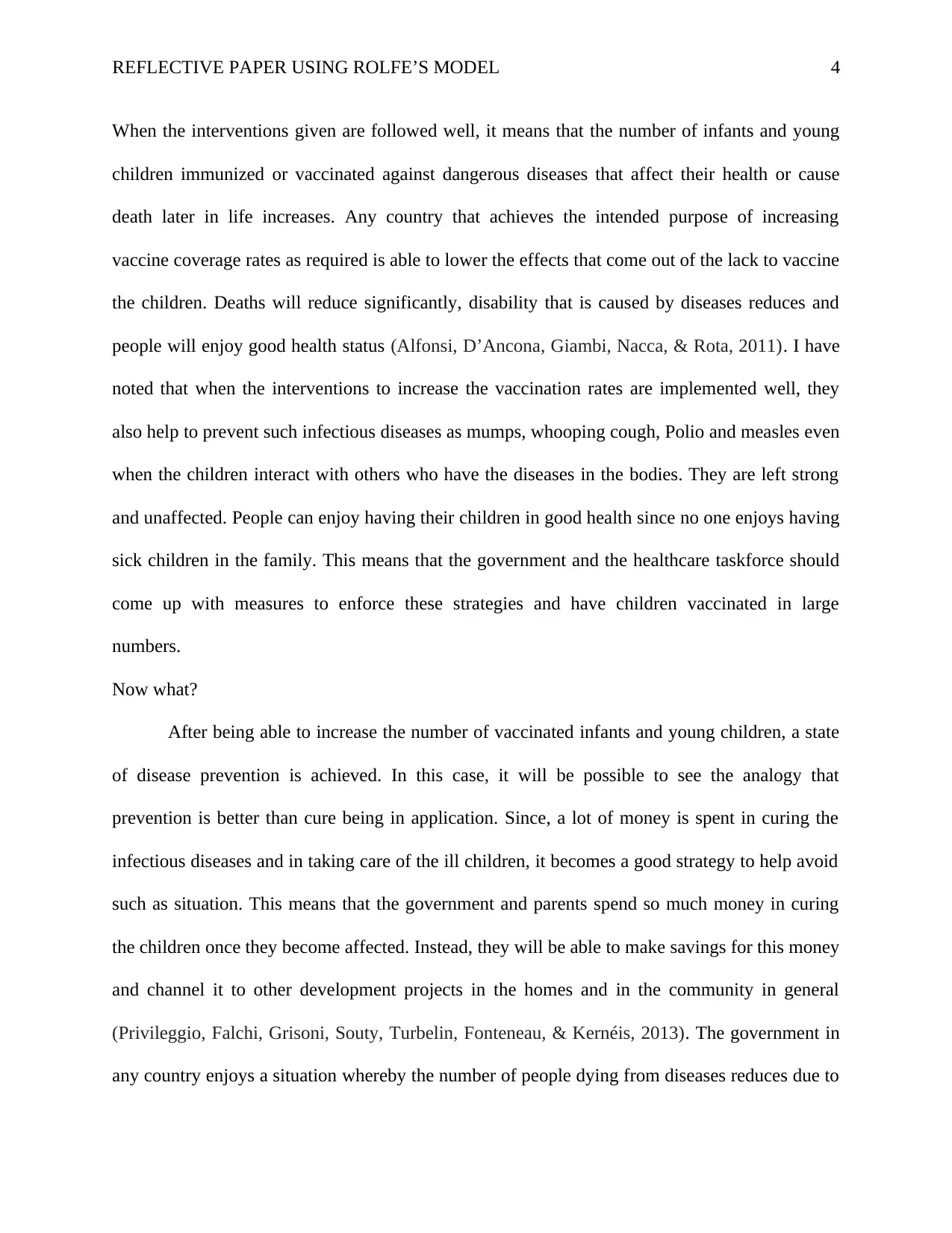
REFLECTIVE PAPER USING ROLFE’S MODEL 4
When the interventions given are followed well, it means that the number of infants and young
children immunized or vaccinated against dangerous diseases that affect their health or cause
death later in life increases. Any country that achieves the intended purpose of increasing
vaccine coverage rates as required is able to lower the effects that come out of the lack to vaccine
the children. Deaths will reduce significantly, disability that is caused by diseases reduces and
people will enjoy good health status (Alfonsi, D’Ancona, Giambi, Nacca, & Rota, 2011). I have
noted that when the interventions to increase the vaccination rates are implemented well, they
also help to prevent such infectious diseases as mumps, whooping cough, Polio and measles even
when the children interact with others who have the diseases in the bodies. They are left strong
and unaffected. People can enjoy having their children in good health since no one enjoys having
sick children in the family. This means that the government and the healthcare taskforce should
come up with measures to enforce these strategies and have children vaccinated in large
numbers.
Now what?
After being able to increase the number of vaccinated infants and young children, a state
of disease prevention is achieved. In this case, it will be possible to see the analogy that
prevention is better than cure being in application. Since, a lot of money is spent in curing the
infectious diseases and in taking care of the ill children, it becomes a good strategy to help avoid
such as situation. This means that the government and parents spend so much money in curing
the children once they become affected. Instead, they will be able to make savings for this money
and channel it to other development projects in the homes and in the community in general
(Privileggio, Falchi, Grisoni, Souty, Turbelin, Fonteneau, & Kernéis, 2013). The government in
any country enjoys a situation whereby the number of people dying from diseases reduces due to
When the interventions given are followed well, it means that the number of infants and young
children immunized or vaccinated against dangerous diseases that affect their health or cause
death later in life increases. Any country that achieves the intended purpose of increasing
vaccine coverage rates as required is able to lower the effects that come out of the lack to vaccine
the children. Deaths will reduce significantly, disability that is caused by diseases reduces and
people will enjoy good health status (Alfonsi, D’Ancona, Giambi, Nacca, & Rota, 2011). I have
noted that when the interventions to increase the vaccination rates are implemented well, they
also help to prevent such infectious diseases as mumps, whooping cough, Polio and measles even
when the children interact with others who have the diseases in the bodies. They are left strong
and unaffected. People can enjoy having their children in good health since no one enjoys having
sick children in the family. This means that the government and the healthcare taskforce should
come up with measures to enforce these strategies and have children vaccinated in large
numbers.
Now what?
After being able to increase the number of vaccinated infants and young children, a state
of disease prevention is achieved. In this case, it will be possible to see the analogy that
prevention is better than cure being in application. Since, a lot of money is spent in curing the
infectious diseases and in taking care of the ill children, it becomes a good strategy to help avoid
such as situation. This means that the government and parents spend so much money in curing
the children once they become affected. Instead, they will be able to make savings for this money
and channel it to other development projects in the homes and in the community in general
(Privileggio, Falchi, Grisoni, Souty, Turbelin, Fonteneau, & Kernéis, 2013). The government in
any country enjoys a situation whereby the number of people dying from diseases reduces due to
Paraphrase This Document
Need a fresh take? Get an instant paraphrase of this document with our AI Paraphraser
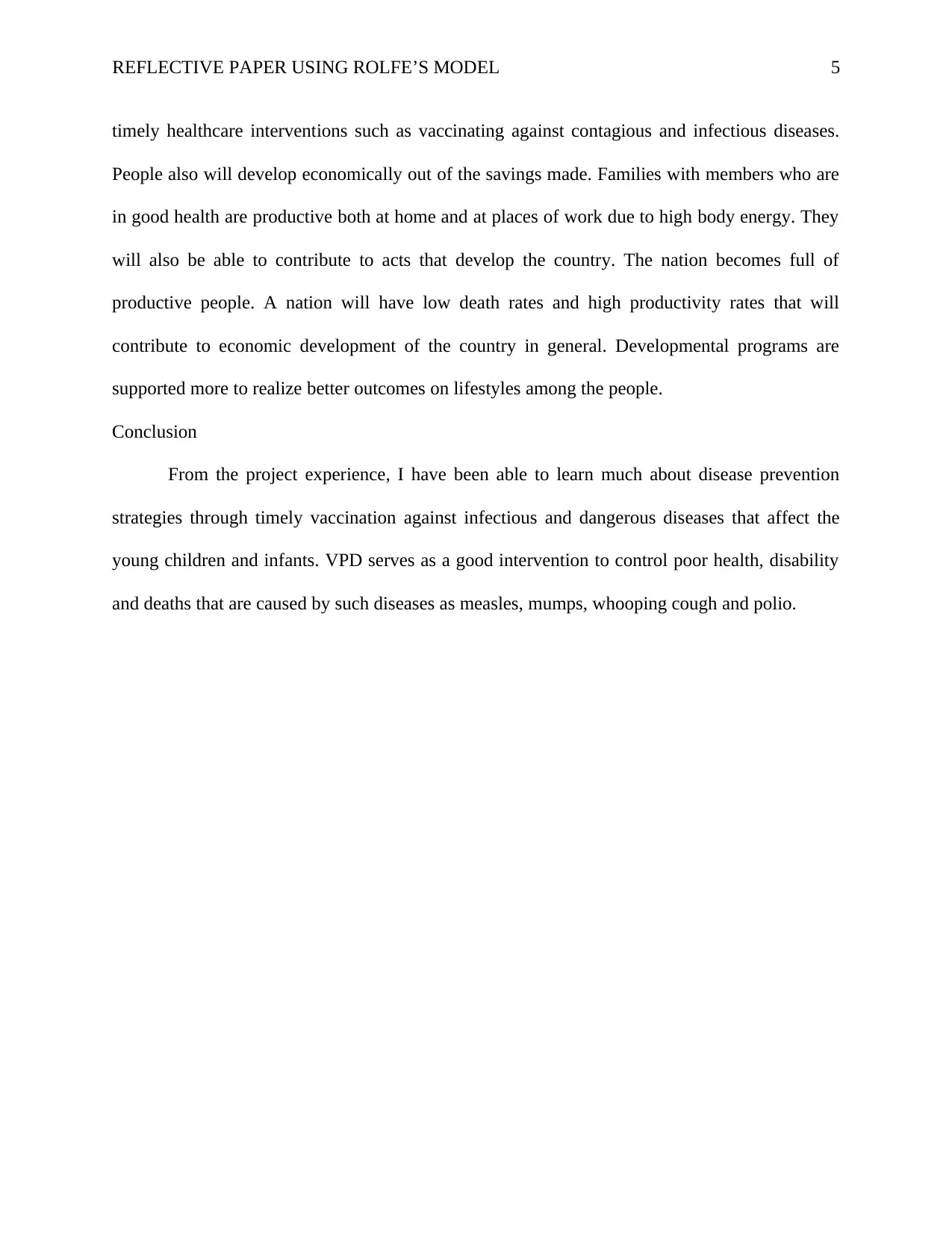
REFLECTIVE PAPER USING ROLFE’S MODEL 5
timely healthcare interventions such as vaccinating against contagious and infectious diseases.
People also will develop economically out of the savings made. Families with members who are
in good health are productive both at home and at places of work due to high body energy. They
will also be able to contribute to acts that develop the country. The nation becomes full of
productive people. A nation will have low death rates and high productivity rates that will
contribute to economic development of the country in general. Developmental programs are
supported more to realize better outcomes on lifestyles among the people.
Conclusion
From the project experience, I have been able to learn much about disease prevention
strategies through timely vaccination against infectious and dangerous diseases that affect the
young children and infants. VPD serves as a good intervention to control poor health, disability
and deaths that are caused by such diseases as measles, mumps, whooping cough and polio.
timely healthcare interventions such as vaccinating against contagious and infectious diseases.
People also will develop economically out of the savings made. Families with members who are
in good health are productive both at home and at places of work due to high body energy. They
will also be able to contribute to acts that develop the country. The nation becomes full of
productive people. A nation will have low death rates and high productivity rates that will
contribute to economic development of the country in general. Developmental programs are
supported more to realize better outcomes on lifestyles among the people.
Conclusion
From the project experience, I have been able to learn much about disease prevention
strategies through timely vaccination against infectious and dangerous diseases that affect the
young children and infants. VPD serves as a good intervention to control poor health, disability
and deaths that are caused by such diseases as measles, mumps, whooping cough and polio.
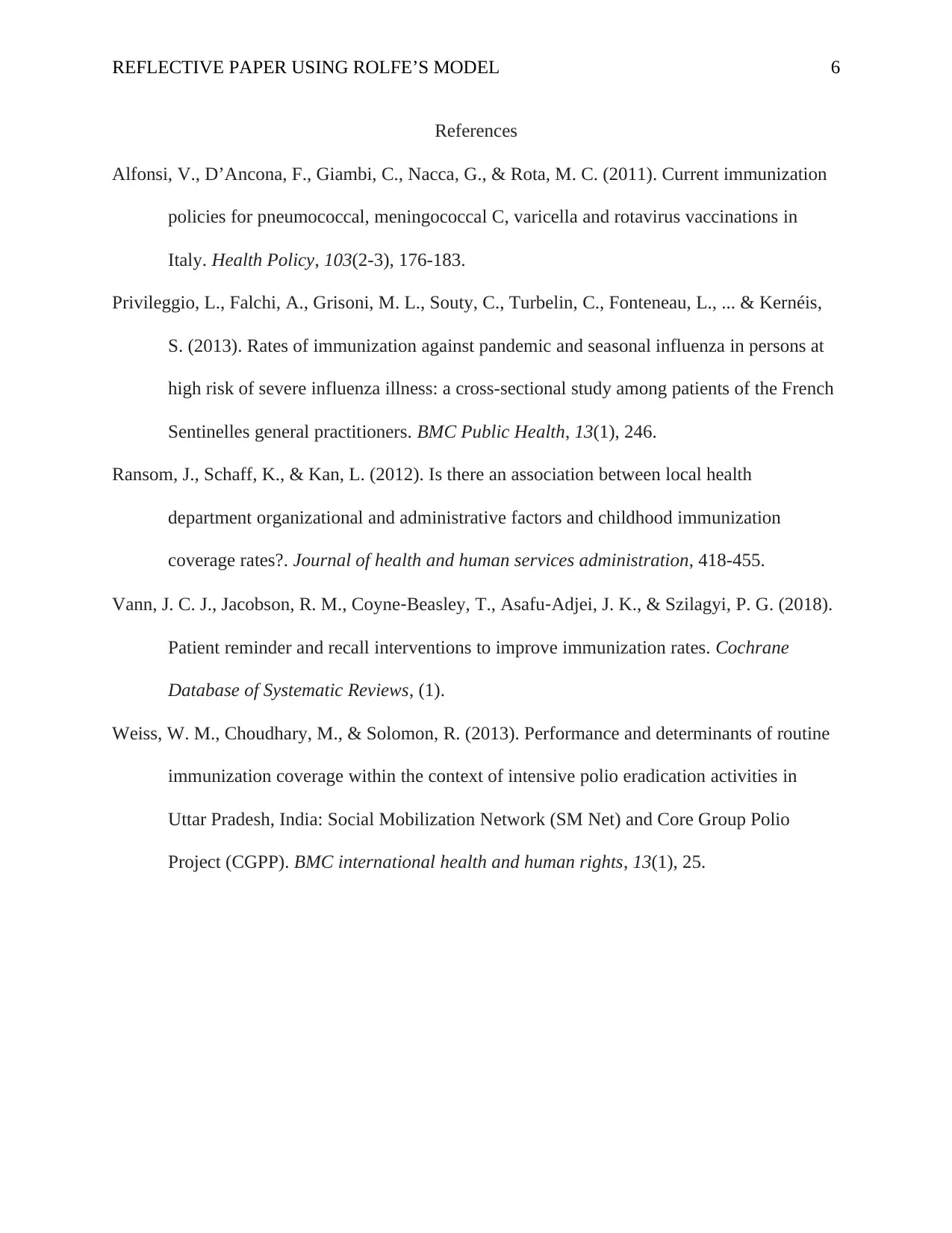
REFLECTIVE PAPER USING ROLFE’S MODEL 6
References
Alfonsi, V., D’Ancona, F., Giambi, C., Nacca, G., & Rota, M. C. (2011). Current immunization
policies for pneumococcal, meningococcal C, varicella and rotavirus vaccinations in
Italy. Health Policy, 103(2-3), 176-183.
Privileggio, L., Falchi, A., Grisoni, M. L., Souty, C., Turbelin, C., Fonteneau, L., ... & Kernéis,
S. (2013). Rates of immunization against pandemic and seasonal influenza in persons at
high risk of severe influenza illness: a cross-sectional study among patients of the French
Sentinelles general practitioners. BMC Public Health, 13(1), 246.
Ransom, J., Schaff, K., & Kan, L. (2012). Is there an association between local health
department organizational and administrative factors and childhood immunization
coverage rates?. Journal of health and human services administration, 418-455.
Vann, J. C. J., Jacobson, R. M., Coyne‐Beasley, T., Asafu‐Adjei, J. K., & Szilagyi, P. G. (2018).
Patient reminder and recall interventions to improve immunization rates. Cochrane
Database of Systematic Reviews, (1).
Weiss, W. M., Choudhary, M., & Solomon, R. (2013). Performance and determinants of routine
immunization coverage within the context of intensive polio eradication activities in
Uttar Pradesh, India: Social Mobilization Network (SM Net) and Core Group Polio
Project (CGPP). BMC international health and human rights, 13(1), 25.
References
Alfonsi, V., D’Ancona, F., Giambi, C., Nacca, G., & Rota, M. C. (2011). Current immunization
policies for pneumococcal, meningococcal C, varicella and rotavirus vaccinations in
Italy. Health Policy, 103(2-3), 176-183.
Privileggio, L., Falchi, A., Grisoni, M. L., Souty, C., Turbelin, C., Fonteneau, L., ... & Kernéis,
S. (2013). Rates of immunization against pandemic and seasonal influenza in persons at
high risk of severe influenza illness: a cross-sectional study among patients of the French
Sentinelles general practitioners. BMC Public Health, 13(1), 246.
Ransom, J., Schaff, K., & Kan, L. (2012). Is there an association between local health
department organizational and administrative factors and childhood immunization
coverage rates?. Journal of health and human services administration, 418-455.
Vann, J. C. J., Jacobson, R. M., Coyne‐Beasley, T., Asafu‐Adjei, J. K., & Szilagyi, P. G. (2018).
Patient reminder and recall interventions to improve immunization rates. Cochrane
Database of Systematic Reviews, (1).
Weiss, W. M., Choudhary, M., & Solomon, R. (2013). Performance and determinants of routine
immunization coverage within the context of intensive polio eradication activities in
Uttar Pradesh, India: Social Mobilization Network (SM Net) and Core Group Polio
Project (CGPP). BMC international health and human rights, 13(1), 25.
⊘ This is a preview!⊘
Do you want full access?
Subscribe today to unlock all pages.

Trusted by 1+ million students worldwide
1 out of 6
Related Documents
Your All-in-One AI-Powered Toolkit for Academic Success.
+13062052269
info@desklib.com
Available 24*7 on WhatsApp / Email
![[object Object]](/_next/static/media/star-bottom.7253800d.svg)
Unlock your academic potential
Copyright © 2020–2025 A2Z Services. All Rights Reserved. Developed and managed by ZUCOL.





